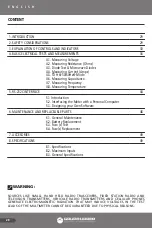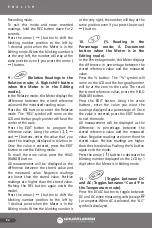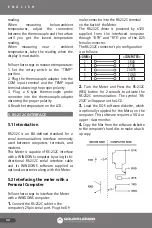
E N G L I S H
38
may be unstable due to environmentally
induced electrical noise. In this case,
directly connect the resistor to input
terminals of the Meter or shield the
resistor at potential of the COM input
terminal to obtain stable reading.
• For resistance above 1Megohm, the
display may take a few seconds to
stabilize. This is normal for high-resistance
readings.
• The Meter has a circuit to protect the
resistance range from over-voltage (600V
AC). However, to prevent accidentally
exceeding the protection circuit’s rating
and to ensure a correct measurement,
NEVER CONECT THE TEST LEADS TO A
SOURCE OF VOLTAGE when the rotary
switch is set to Ω or or
functions.
• The current applied during resistance
measurements could damage some
devices. The table below lists the test
voltage and current available for each
resistance measurement range. (All values
are typical).
RANGE
OPEN CIRCUIT
VOL
TAGE (A)
FULL SCALE
VOL
TAGE (B)
SHOR
T
CIRCUIT
CURRENT (C)
400 Ω
< 1.2 V
< 200mV
< 740 μA
4 KΩ
< 320mV
< 60 μA
40 KΩ
< 340mV
< 11 μA
400 KΩ
< 340mV
< 1.5 μA
4 MΩ
< 340mV
< 0.2 μA
40 MΩ
< 1 mV
< 0.2 μA
NOTE:
(A) is the open circuit test voltage at the
input terminals in volts.
(B) is the voltage drop across a resistance
equal.
(C) is the current through a short circuit at
the input terminals.
4.2.1 Measuring Resistance (Ohms)
When measuring resistance, be sure that
the contact between the test leads and the
circuit under test is good. Dirt, oil, solder
flux, or other foreign matter seriously affect
the reading value.
Follow these steps to measure ohms:
1. Set the Function switch to the desired “Ω”
position.
2. Insert the black test lead into the “COM”
input terminal and the red test lead into the
“VΩHz CAP” input terminal.
3. Connect the test leads to the circuit to be
measured.
4. The measured resistance will be displayed
on the LCD.















































